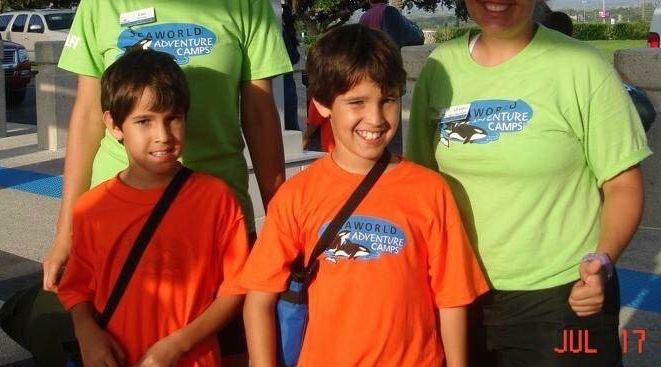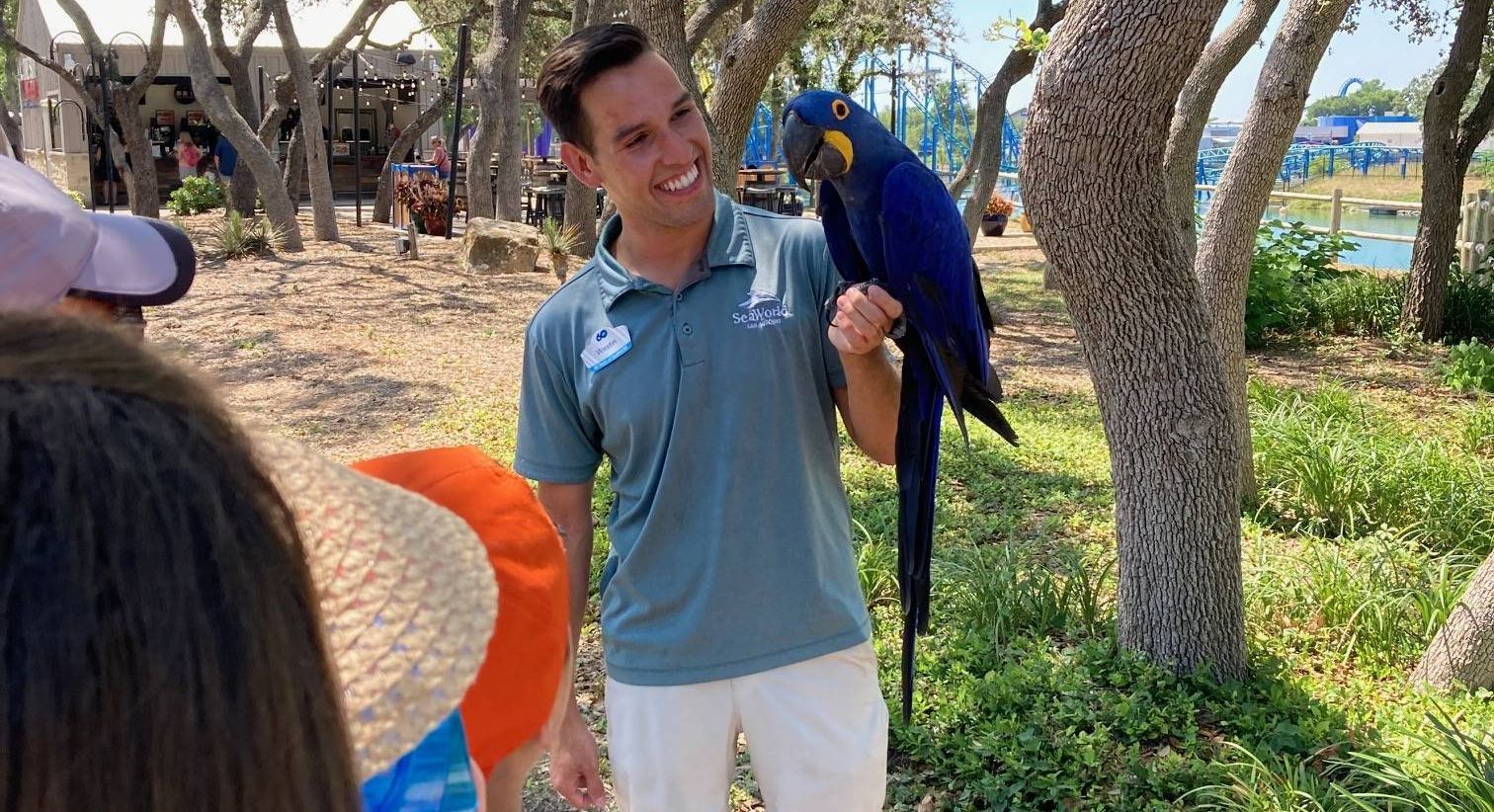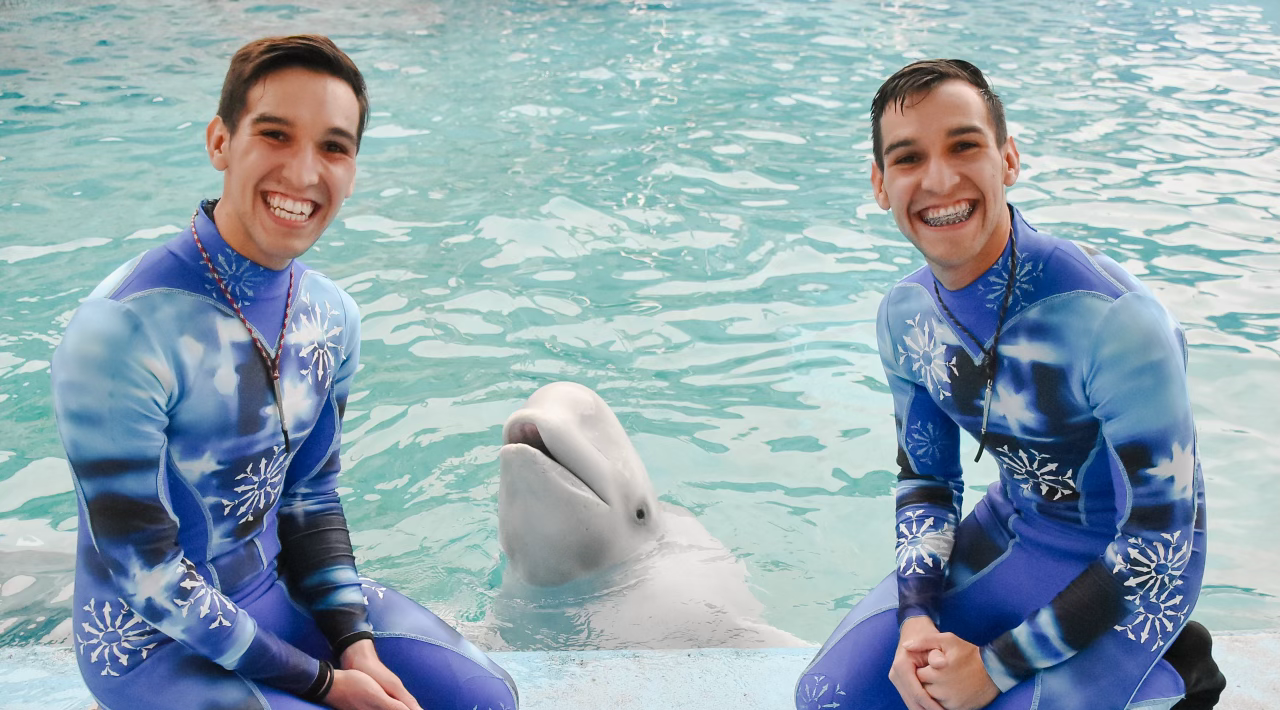Twin brothers are turning heads while fulfilling their dreams as SeaWorld trainers
Working with the animals has taught them a lot about connection.

Jakob and Westin Fenton at SeaWorld San Antonio.
Visitors to SeaWorld Sea Antonio, Texas have been doing double takes for the past 5 years after running into identical twin brothers Westin and Jakob Fenton. Guests often catch Westin educating children about exotic birds as a member of the Animal Ambassadors team near the park’s entrance. Then, a few minutes later, spot Jakob in a wet suit at the Orca Encounter.
“Every day it's like, 'Didn't I just see you?’” Westin told Upworthy. “It surprises them,” Jakob added. When Westin had braces, countless visitors frantically approached Jakob with a confused look, asking, “When did you get your braces off?”
The 23-year-old twins have been turning heads at SeaWorld since they were young boys and began attending the park’s summer camps at 7.
"They were the cutest. You could tell how obsessed they were with the animals. It made me so happy years later when they got hired here and to see how well they both do,” Kari Tomarelli, a trainer at Orca Encounter, shared with Upworthy.

Jakob and Westin Fenton at SeaWorld San Antonio.
via SeaWorld (used with permission)
From a very young age, the Fenton twins knew SeaWorld was more than just a place they visited—it was their destiny. "It was during my time away from SeaWorld that I realized, 'This is where I'm meant to be,'" Westin shared. "We've always been the twins who do everything together. Same friends, same passions, extracurriculars... everything,” Jakob added.
So, pursuing the same career wasn’t a big stretch for the twins.
The twins are incredibly close, but they also allow plenty of space for their animal companions at SeaWorld. Jakob spends a lot of his time, energy and heart caring for two of the park's five orcas: Kamea, a 10-year-old 3,000-pound female, and Tuar, the park’s dominant male, who is 24 years old and weighs over 8,000 pounds.
The pair couldn’t be more different.
"Tuar is very goofy; he has a great attitude," Jakob said, noting that even after a challenging training session, “he's just happy to be there.” Conversely, things haven’t been so easy with Kamea. “It took time to earn her trust, and it took months to develop a relationship,” Jakob admitted. “Now, I actually adore her."

Jakob Fenton at the Orca Encounter.
via SeaWorld (used with permission)
Even though park visitors see Jakob in a wetsuit, giving hand signals at the Orca Encounter presentation, most of his job takes place backstage, holding a scrubber. “Eighty percent of being a trainer is cleaning,” he told Upworthy. “We need to make sure that these animals are in a clean environment so our morning is 3 or 4 hours of maintaining habitats. Scrubbing ledges, cleaning glass, cleaning fish buckets."
While Jakob's role as an orca trainer may seem glamorous, he sees it as a platform to serve the animals and educate guests. His responsibility is more significant given the scrutiny marine parks have been under in recent years and the fact that this is the last generation of orcas under SeaWorld's care.
“Being able to introduce people who've never seen a killer whale and then have them walk away with an appreciation of the species and a desire to protect them in the wild means everything,” Jakob said.
While Jakob is loading up buckets of salmon for the Orca Encounter, on the other side of the park, you’ll run into Westin, presenting one of SeaWorld San Antonio's 17 exotic animals—most of which were rescued and rehabilitated—to gawking park guests. As an Animal Ambassador, Westin educates guests about exotic reptiles, birds, and small mammals. He also travels with his animal companions to nearby schools, retirement homes and hospitals to introduce them to the public.

Westin Fenton and Azul at SeaWorld San Antonio.
via Tod Perry (used with permission)
When he’s not taking questions from park guests about his animal companions, such as Star the bald eagle or Azul the hyacinth macaw, he’s flashing his pearly (and recently straightened) whites for photos with guests. He estimates he poses for about 50 a day.
While many would assume training means exerting authority over the animals to force them to do desired behaviors, Westin says it’s all about building relationships. "We're simply asking, 'Hey, would you like to come and participate?’ And Star has every opportunity to say no or to say yes,” he told Upworthy. “Everything is an ask. I'm not expecting Star to do anything. Whatever Star would like, we do."
Even though people have difficulty telling the twins apart, the animals can tell the difference. "They learn our behavior just like we learn theirs,” he told Upworthy.
The twins spend much of their lives together at SeaWorld and as Pilates instructors on the side, so what sets them apart? "Westin is a little more tamed. More reserved and to himself. Whereas Jakob is the life of the party,” Cesi Buitrago, a trainer at Orca Encounter, said. They also have one big difference in diet: Westin can’t stand cheese on his burger, but Jakob loves it.

The Fenton twins with a beluga whale.
via SeaWorld (used with permission)
For the Fenton twins, life at SeaWorld has taught them a lot about the animal kingdom, but it has also changed how they see humans.
“I had no idea the impact these whales would have on my life and how they would teach me how to be a better human and mentor,” Jakob told Upworthy. “Building my relationships with them, I can use what I've learned when thinking about developing a relationship with a human. They teach me to be patient, to listen, to invest, to really get to know someone. Don’t fake it. I never would have imagined all of these life skills I would have learned from killer whales."
It’s no surprise that Westin has come away with a similar lesson.
"So much of what we do is relationships. [The animals] have taught me what it takes to get to know someone; they’ve taught me patience, just really connecting on a deeper level,” Westin says. “I've learned a lot about life and, ultimately, connection."

